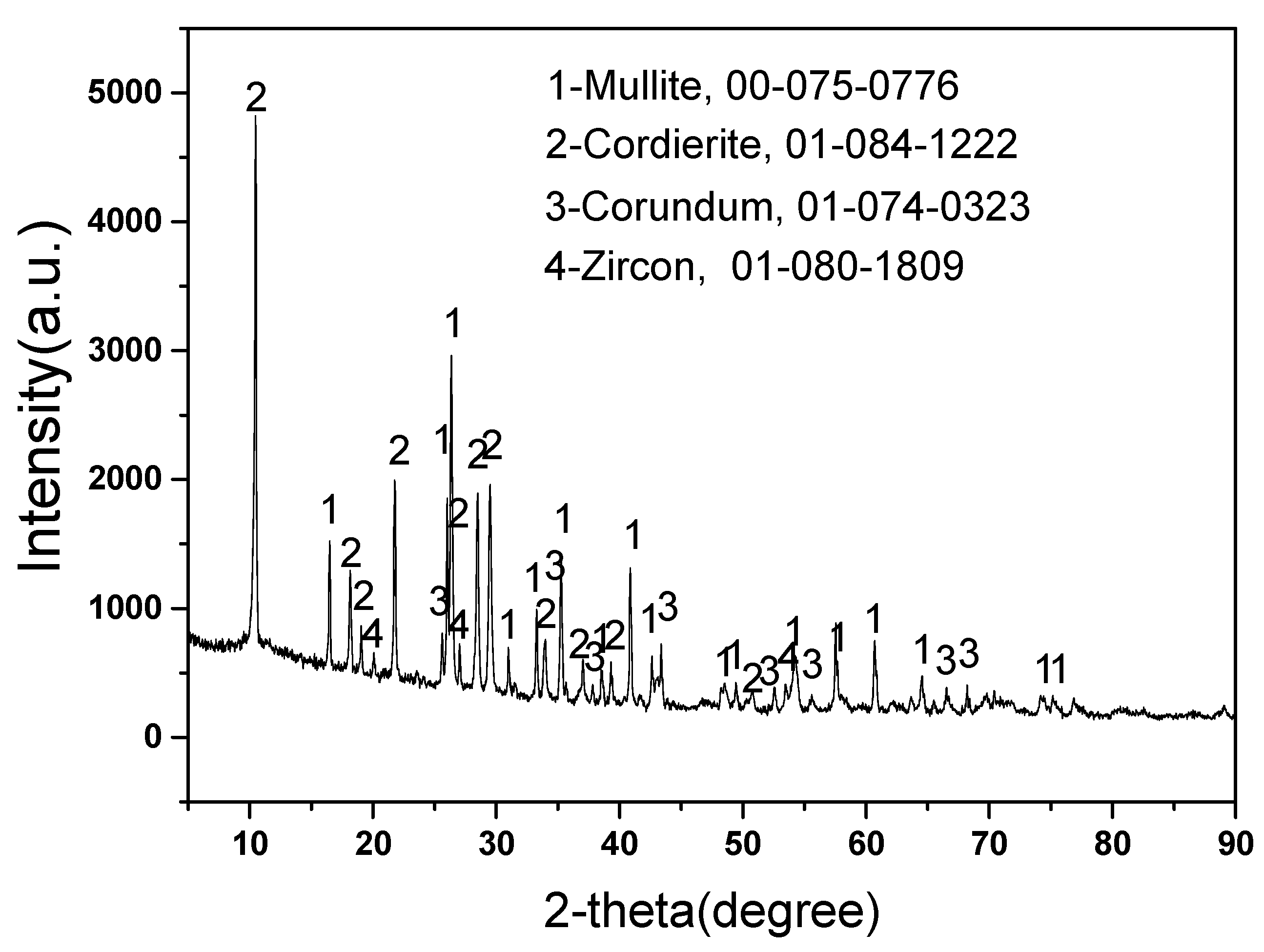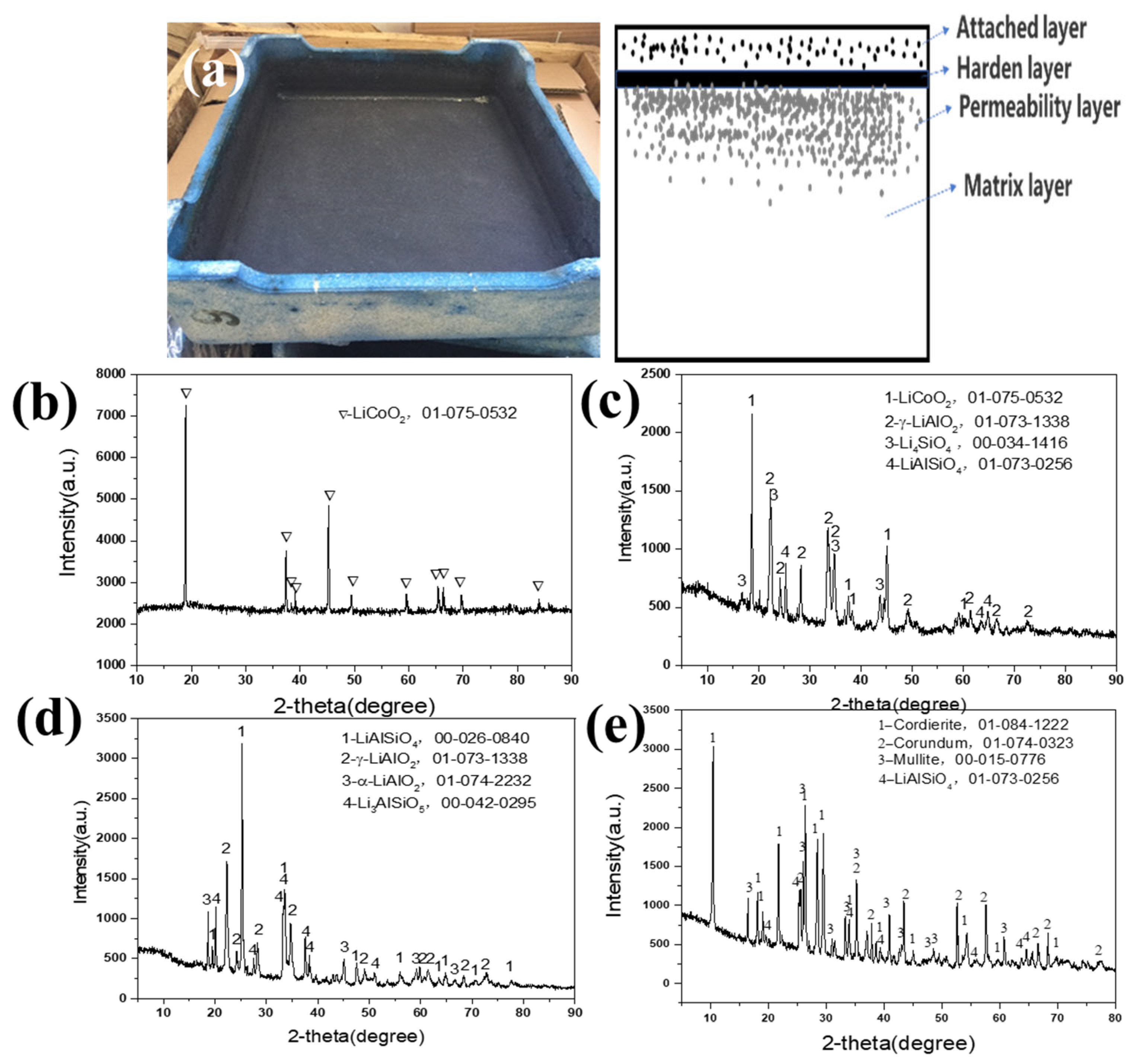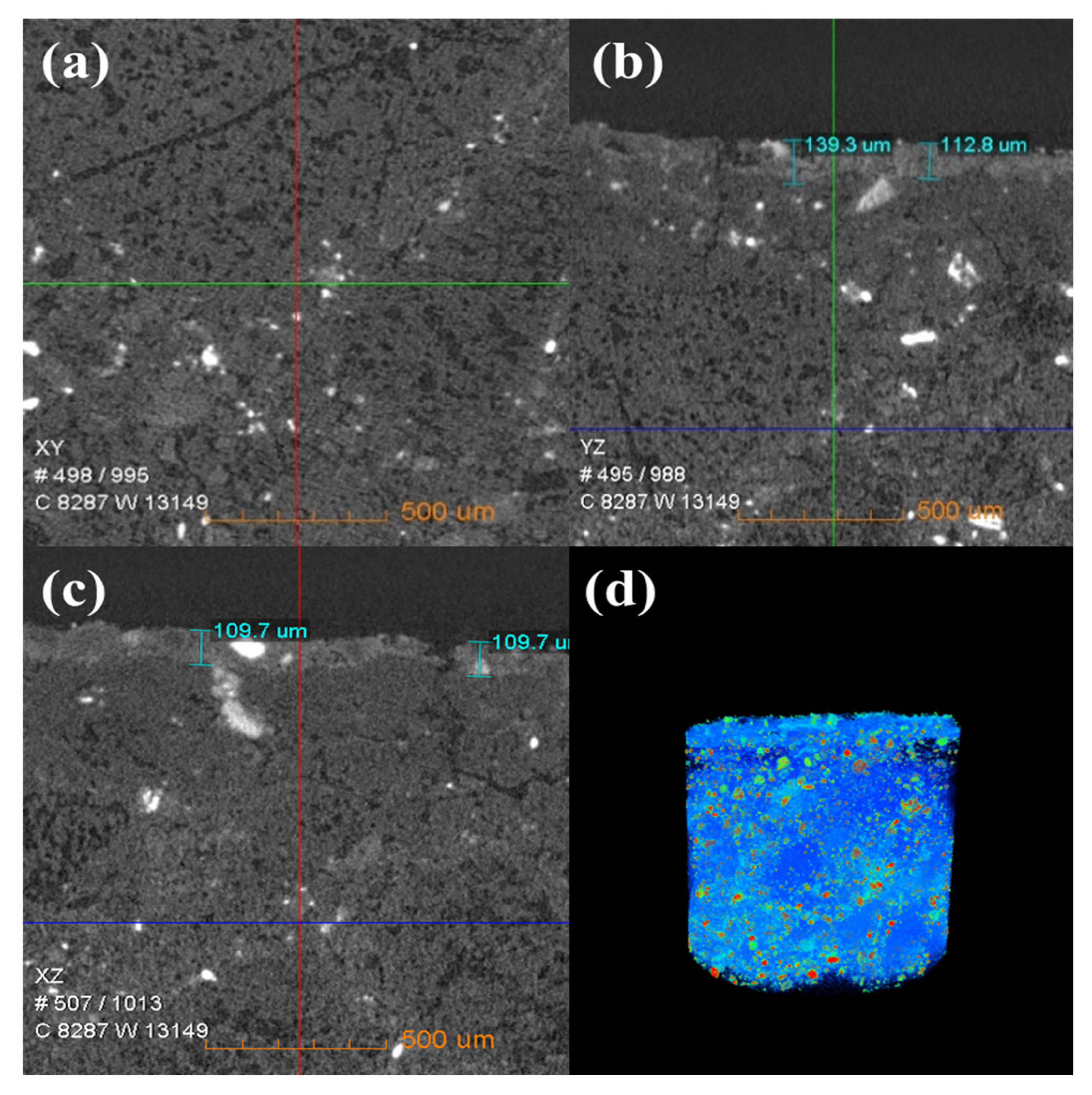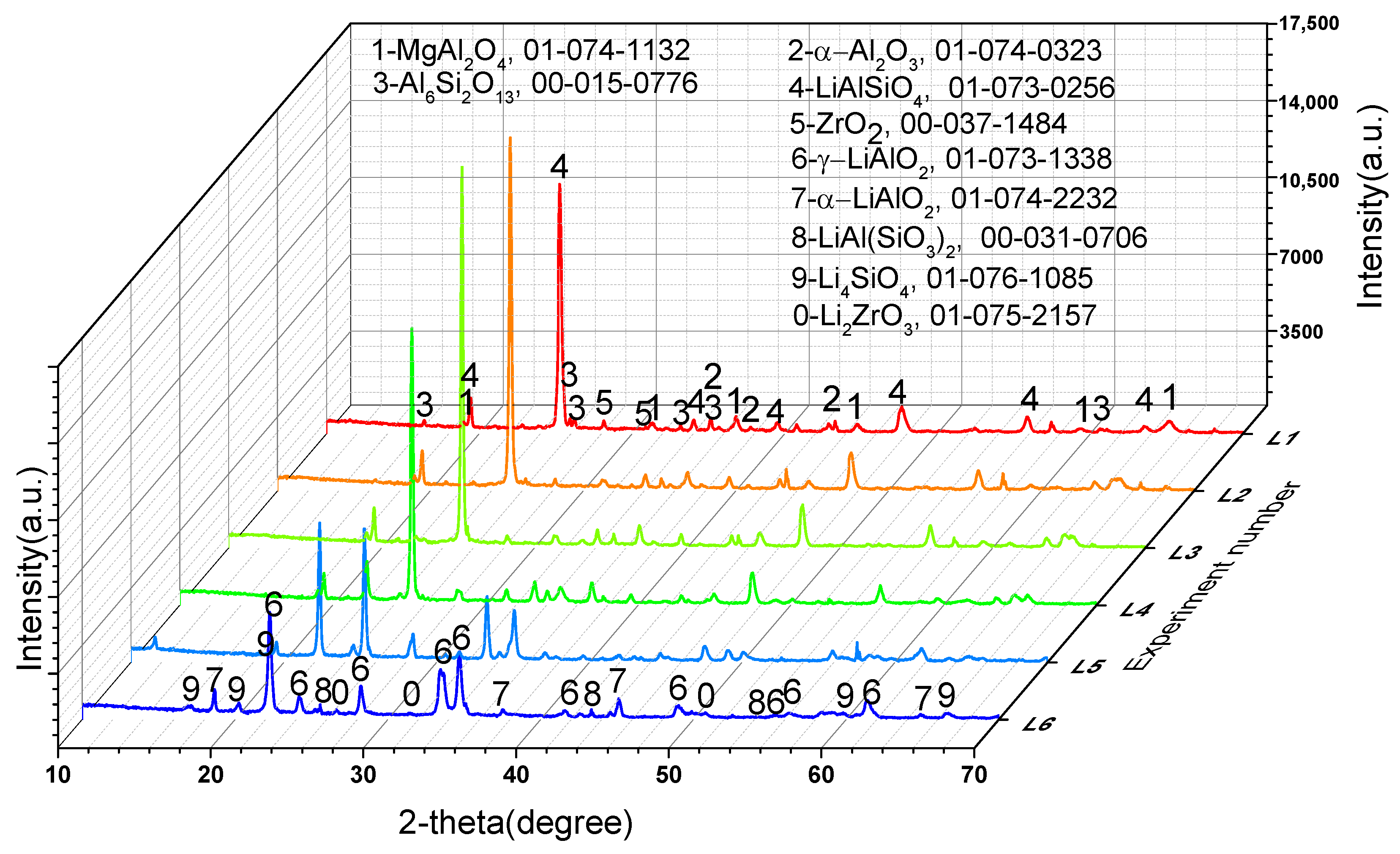Corrosion Behavior of Cobalt Oxide and Lithium Carbonate on Mullite–Cordierite Saggar Used for Lithium Battery Cathode Material Sintering
Abstract
1. Introduction
2. Materials and Methods
2.1. Material Preparation
2.2. Sample Characterization Techniques
3. Results
3.1. Phase Analyses of New and Waste Saggar
3.2. Analysis of Micromorphology and Elemental Distribution
3.3. Analysis of Internal Spatial Structure
3.4. Speculation on Reaction Mechanism and Verification
- R1: Li2CO3 + Al2O3(C) = 2LiAlO2 + CO2(g)↑
- R2: 3Li2CO3 + Al6Si2O13 = 2LiAlSiO4 + 3CO2(g)↑ + 4LiAlO2
- R3: 7Li2CO3 + Al6Si2O13 = 2Li4SiO4 + 6LiAlO2 + 7CO2(g)↑
- R4: LiAlSiO4 + 2Li2CO3 = LiAlO2 + Li4SiO4 + 2CO2(g)↑
- R5: 10Li2CO3 + Mg2Al4Si5O18 = 5Li4SiO4 + 2MgAl2O4 + 10CO2(g)↑
- R6: 3Li2CO3 + ZrSiO4 = Li2ZrO3 + 3CO2(g)↑ + Li4SiO4
- R7: 2Li2CO3 + ZrSiO4 = ZrO2 + 2CO2(g)↑ + Li4SiO4
- R8: 2Co3O4 + 6Al2O3(C) = 6CoAl2O4 + O2(g)↑
- R9: 2Co3O4 + 1.2Al6Si2O13 = 1.2 CoAl2O4 + 2.4Co2SiO4 + O2(g)↑
- R10: 3.333Co3O4 + Mg2Al4Si5O18 = 5Co2SiO4+ 1.666O2(g)↑ + 2MgAl2O4
4. Conclusions
- (1)
- LiAlO2 and Li4SiO4 are the main phases after the reaction of sufficient lithium carbonate with aluminum compound. LiAlSiO4 and aluminum silicon lithium compounds are intermediate reaction products when lithium carbonate reactants are insufficient;
- (2)
- TOF-SIMS analysis proves that the maximum erosion penetration of lithium can reach 2 mm. Cobalt erosion only occurs on the saggar’s surface, forming cobalt silicate and cobalt aluminum spinel;
- (3)
- X-ray CT analysis shows that the internal reaction at the interface of lithium before and after the reaction leads to changes in the product’s density before and after the reaction, and the further volume change leads to saggar rupture. The CO2 and O2 generated by the reaction further aggravate the internal cracks of the material–saggar interface;
- (4)
- The subsequent preparation of new, improved saggars must focus on solving issues regarding lithium penetration of interfacial products, which results in volume changes. Finally, for waste saggar disposal and utilization, lithium distribution should be considered to improve the overall utilization.
Author Contributions
Funding
Institutional Review Board Statement
Informed Consent Statement
Data Availability Statement
Conflicts of Interest
References
- Zhao, Y.; Yuan, X.; Jiang, L.; Wen, J.; Wang, H.; Guan, R.; Zhang, J.; Zeng, G. Regeneration and reutilization of cathode materials from spent lithium-ion batteries. Chem. Eng. J. 2020, 383, 123089. [Google Scholar] [CrossRef]
- Min, X.; Sun, B.; Chen, S.; Fang, M.; Wu, X.; Liu, Y.G.; Abdelkader, A.; Huang, Z.; Liu, T.; Xi, K.; et al. A textile-based SnO2 ultra-flexible electrode for lithium-ion batteries. Energy Storage Mater. 2019, 16, 597–606. [Google Scholar] [CrossRef]
- Min, X.; Xiao, J.; Fang, M.; Wang, W.; Zhao, Y.; Liu, Y.; Abdelkader, A.M.; Xi, K.; Kumar, R.V.; Huang, Z. Potassium-ion batteries: Outlook on present and future technologies. Energy Environ. Sci. 2021, 14, 2186–2243. [Google Scholar] [CrossRef]
- Liao, Z.; Zhang, S.; Li, K.; Zhang, G.; Habetler, T.G. A survey of methods for monitoring and detecting thermal runaway of lithium-ion batteries. J. Power Sources 2019, 436, 19. [Google Scholar] [CrossRef]
- Porthault, H.; Cras, F.L.; Franger, S. Synthesis of LiCoO2 thin films by sol/gel process. J. Power Sources 2010, 195, 6262–6267. [Google Scholar] [CrossRef]
- Ning Chen, B.L.; Gui, W.; Xu, S.; Wang, J.; Dai, J. Research on temperature field change trend of the sintering process for lithium-ion battery cathode materials. IFAC-PapersOnLine 2018, 51, 307–312. [Google Scholar] [CrossRef]
- Duan, X.; Zheng, H.; Chen, Y.; Qian, F.; Liu, G.; Wang, X.; Si, Y. Study on the corrosion resistance of cordierite-mullite and SiC refractories to Li-ion ternary cathode materials. Ceram. Int. 2020, 46, 2829–2835. [Google Scholar] [CrossRef]
- Zhai, P.T.; Chen, L.G.; Yin, Y.M.; Li, S.P.; Ding, D.F.; Ye, G.T. Interactions between mullite saggar refractories and Li-ion battery cathode materials during calcination. J. Eur. Ceram. Soc. 2018, 38, 2145–2151. [Google Scholar] [CrossRef]
- Zhai, P.; Chen, L.; Hu, S.; Zhang, X.; Ding, D.; Li, H.; Li, S.; Zhu, L.; Ye, G. Comparison of interactions of MgO-based refractories with Li-ion battery cathode materials during calcination. Int. J. Appl. Ceram. Tec. 2019, 16, 287–293. [Google Scholar] [CrossRef]
- Huang, H.; Huang, Z.; Fang, M.; Liu, Y.; Jiang, B. Erosion Resistance of Magnesia-alumina Spinel in Synthesis Process of Lithium Cobaltaoxide. Bull. Chin. Ceramic. Soc. 2011, 30, 515–518. [Google Scholar]
- Ding, D.; Ye, G.; Chen, L. Superior corrosion resistance KAlSi2O6-containing materials for calcining Li-ion battery cathode materials. Corros. Sci. 2019, 157, 324–330. [Google Scholar] [CrossRef]
- Ding, D.; Chen, L.; Liao, G.; Zheng, L.; Gao, S.; Ye, G. Preparation of andalusite-corundum-KAlSi2O6 material for the calcination of Li-ion battery cathode materials. J. Alloys Compd. 2019, 798, 367–374. [Google Scholar] [CrossRef]
- Kakroudi, M.G.; Vafa, N.P.; Asl, M.S.; Shokouhimehr, M. Effects of SiC content on thermal shock behavior and elastic modulus of cordierite–mullite composites. Ceram. Int. 2020, 46, 23780–23784. [Google Scholar] [CrossRef]
- Wilson, P.J.; Blackburn, S.; Greenwood, R.W.; Prajapti, B.; Smalley, K. The role of zircon particle size distribution, surface area and contamination on the properties of silica–zircon ceramic materials. J. Eur. Ceram. Soc. 2011, 31, 1849–1855. [Google Scholar] [CrossRef]
- Kazemi, A.; Faghihi-Sani, M.A.; Nayyeri, M.J.; Mohammadi, M.; Hajfathalian, M. Effect of zircon content on chemical and mechanical behavior of silica-based ceramic cores. Ceram. Int. 2014, 40, 1093–1098. [Google Scholar] [CrossRef]
- Cornette, P.; Zanna, S.; Seyeux, A.; Costa, D.; Marcus, P. The native oxide film on a model aluminium-copper alloy studied by XPS and ToF-SIMS. Corros. Sci. 2020, 174, 108837. [Google Scholar] [CrossRef]
- Hu, P.; Hou, X.; Zhang, J.; Li, S.; Wu, H.; Damø, A.J.; Li, H.; Wu, Q.; Xi, X. Distribution and occurrence of lithium in high-alumina-coal fly ash. Int. J. Coal Geol. 2018, 189, 27–34. [Google Scholar] [CrossRef]
- Sjövall, P.; Bake, K.D.; Pomerantz, A.E.; Lu, X.; Mitra-Kirtley, S.; Mullins, O.C. Analysis of kerogens and model compounds by time-of-flight secondary ion mass spectrometry (TOF-SIMS). Fuel 2021, 286, 119373. [Google Scholar] [CrossRef]
- Tsai, S.C.; Chen, H.C.; Huang, J.C.; Chang, C.M.; Chou, M.M.C. Size and orientation effect on the mechanical properties of LiAlO2 single crystal. Mater. Sci. Eng. A 2016, 677, 302–306. [Google Scholar] [CrossRef]
- Qi, J.; Ba, J.; Li, H.; Lin, J.; Zheng, X.; Cao, J.; Feng, J. β-LiAlSiO4 reinforced Cu composite interlayer for brazing C/C composites and Nb. Vacuum 2020, 172, 109102. [Google Scholar] [CrossRef]
- Pejchal, J.; Babin, V.; Beitlerova, A.; Kurosawa, S.; Yokota, Y.; Yoshikawa, A.; Nikl, M. Improvement of the growth of Li4SiO4 single crystals for neutron detection and their scintillation and luminescence properties. J. Cryst. Growth 2017, 457, 143–150. [Google Scholar] [CrossRef]
- Isupov, V.P.; Bulina, N.V.; Borodulina, I.A. Effect of the reaction medium on the mechanochemical synthesis of LiAlO2. Inorg. Mater. 2018, 54, 147–155. [Google Scholar] [CrossRef]










| Sample | L1 | L2 | L3 | L4 | L5 | L6 | C1 | C2 | C3 | C4 | C5 | C6 |
|---|---|---|---|---|---|---|---|---|---|---|---|---|
| Saggar Powder | 5 | 5 | 5 | 5 | 5 | 5 | 5 | 5 | 5 | 5 | 5 | 5 |
| Li2CO3 | 5 | 10 | 15 | 20 | 25 | 30 | / | / | / | / | / | / |
| Co3O4 | / | / | / | / | / | / | 5 | 10 | 15 | 20 | 25 | 30 |
Disclaimer/Publisher’s Note: The statements, opinions and data contained in all publications are solely those of the individual author(s) and contributor(s) and not of MDPI and/or the editor(s). MDPI and/or the editor(s) disclaim responsibility for any injury to people or property resulting from any ideas, methods, instructions or products referred to in the content. |
© 2023 by the authors. Licensee MDPI, Basel, Switzerland. This article is an open access article distributed under the terms and conditions of the Creative Commons Attribution (CC BY) license (https://creativecommons.org/licenses/by/4.0/).
Share and Cite
Sun, Z.; Li, S.; Li, H.; Liu, M.; Li, Z.; Liu, X.; Liu, M.; Liu, Q.; Huang, Z. Corrosion Behavior of Cobalt Oxide and Lithium Carbonate on Mullite–Cordierite Saggar Used for Lithium Battery Cathode Material Sintering. Materials 2023, 16, 653. https://doi.org/10.3390/ma16020653
Sun Z, Li S, Li H, Liu M, Li Z, Liu X, Liu M, Liu Q, Huang Z. Corrosion Behavior of Cobalt Oxide and Lithium Carbonate on Mullite–Cordierite Saggar Used for Lithium Battery Cathode Material Sintering. Materials. 2023; 16(2):653. https://doi.org/10.3390/ma16020653
Chicago/Turabian StyleSun, Zhenhua, Shaopeng Li, Huiquan Li, Mingkun Liu, Zhanbing Li, Xianjie Liu, Mingyong Liu, Qiyun Liu, and Zhaohui Huang. 2023. "Corrosion Behavior of Cobalt Oxide and Lithium Carbonate on Mullite–Cordierite Saggar Used for Lithium Battery Cathode Material Sintering" Materials 16, no. 2: 653. https://doi.org/10.3390/ma16020653
APA StyleSun, Z., Li, S., Li, H., Liu, M., Li, Z., Liu, X., Liu, M., Liu, Q., & Huang, Z. (2023). Corrosion Behavior of Cobalt Oxide and Lithium Carbonate on Mullite–Cordierite Saggar Used for Lithium Battery Cathode Material Sintering. Materials, 16(2), 653. https://doi.org/10.3390/ma16020653







